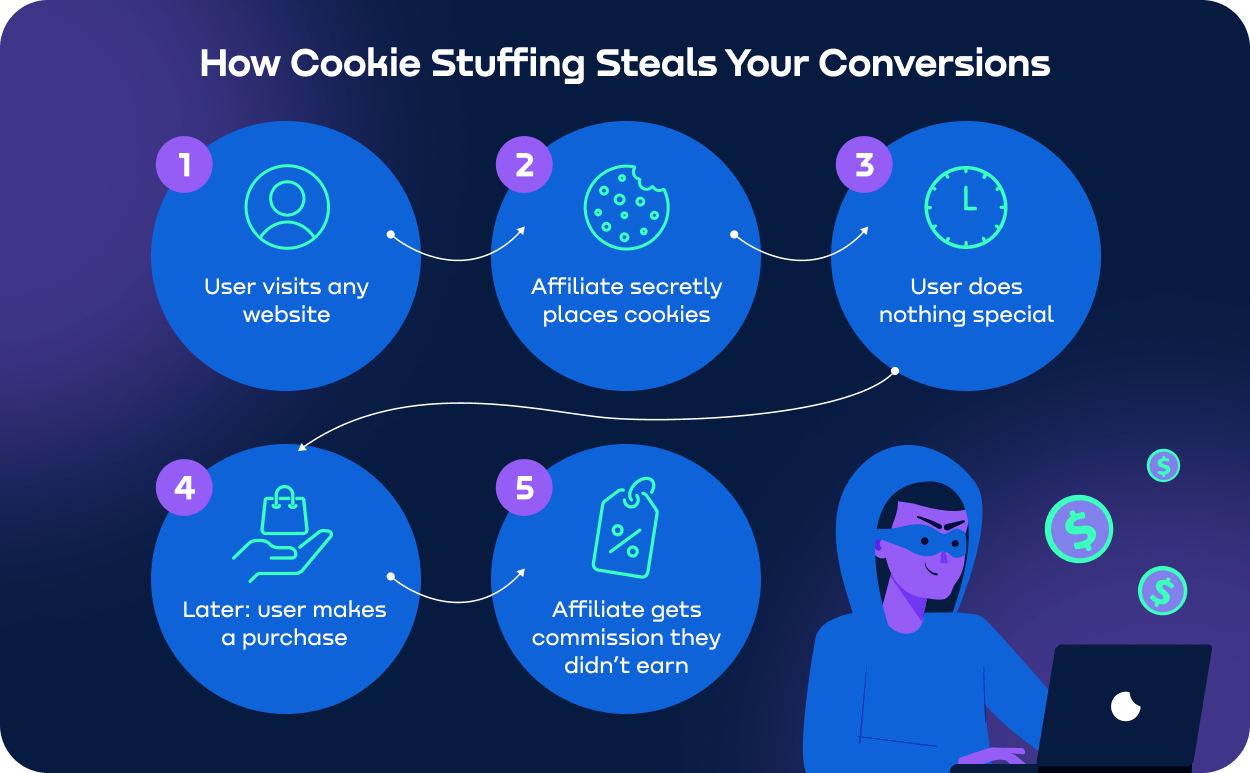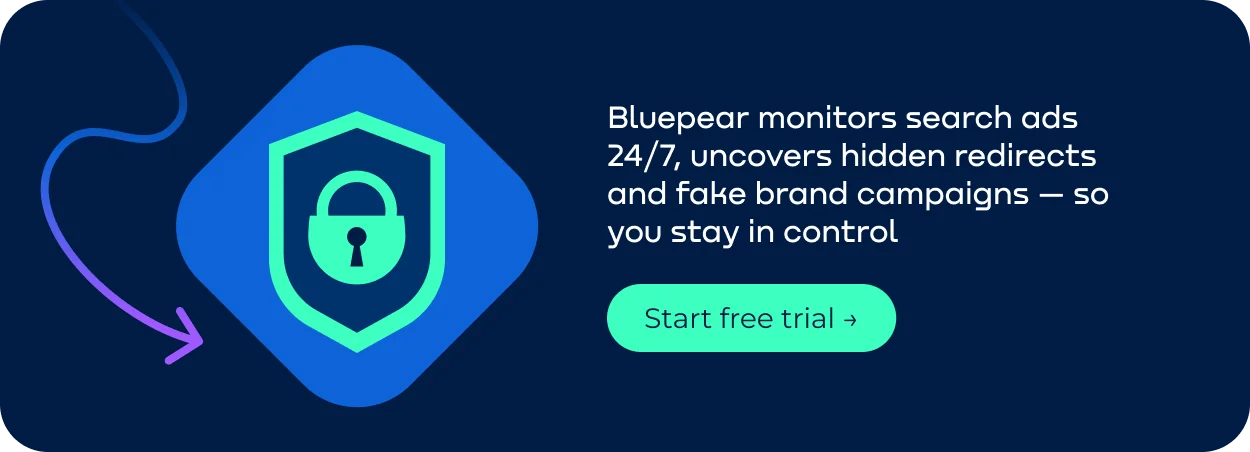
Contents
Did you know how common cookie stuffing is? According to TrafficGuard, cookie stuffing schemes affect between 5% and 10% of all affiliate marketing transactions, resulting in artificial appropriation of sales by affiliates. Such a hidden “leakage” may cost companies thousands or millions of dollars while still staying uncovered.
The case of eBay and its top affiliates is a very illustrative example of affiliate cookie stuffing. In 2013, two leading eBay affiliates were charged with cookie stuffing fraud and subsequently convicted of receiving at least $28 million in commissions. They stole that money from eBay by inserting their cookie files into users’ browsers. That allowed the affiliates to mark the purchases as if they were made through their links. Cookie stuffing can affect any company, no matter how big or small it is. To combat cookie dropping, marketers should educate themselves and search for effective brand protection tools. Let’s learn more about cookie stuffing fraud, how to prevent it and protect your affiliate program from violators.
What Is Cookie Stuffing and How It Works
Normally, users get affiliates’ cookies only when they click the affiliate link. This is how brands can understand that the click or purchase was made because of the affiliate’s promotional efforts. Cookie dropping breaks that logic.
Cookie stuffing allows affiliates to secretly insert their cookies into users’ browsers — even if the user never saw the brand’s promo or clicked anything. As a result, affiliates earn commissions even though they did nothing for the purchase to happen.
Here’s how the mechanism exactly works:
• The affiliate embeds a fraudulent script — on a website, in a banner, in a browser extension, or even through a pop-up ad.
• The user visits the page, and a cookie with the ID of the cheating affiliate is quietly installed in their browser.
• Later, if the user goes to the advertiser's site and makes a purchase, the tracking system sees the installed cookie.
• The system mistakenly believes that the user came from this affiliate — and pays them a commission.
Now that you know what cookie stuffing is, let’s see a real-life example.
Online electronics store TechBuy launches an affiliate program: they pay 5% commission for every order placed through an affiliate link.
Then, an affiliate partner joins their program. Let’s say his name is Alex. He doesn’t want to work on promoting TechBuy offers and attract real customers. Instead, Alex places a cookie stuffing script on a free news site that publishes entertainment content.
What happens next:
• A random user visits the site to read an article about “10 life hacks for smartphones”.
• On this page, Alex’s script is triggered.
• A cookie with Alex’s affiliate ID is installed in the user’s browser, although they didn’t follow the affiliate link.
• Two days later, the user themselves visits TechBuy to buy headphones.
• TechBuy sees the cookie and thinks that the purchase came from Alex.
• Alex gets a 5% commission on the purchase price — simply because the cookie was already in the browser.

That was an example of just one user. Yet, their number may be way bigger as any visitor of the website secretly gets the affiliate’s cookies.
As a result, TechBuy overpays commissions for the purchases that would happen without the unscrupulous affiliate.
Technical Tactics Behind Affiliate Cookie Stuffing
There are several tactics which affiliates can use to perform cookies fraud:
Cookie dropping. An affiliate sets up a script that automatically loads a tracking link when someone opens a webpage — no clicking required. The browser sees the affiliate link as “clicked”, so the cookie is set.
Example: You read a blog post. Behind the scenes, the page silently loads an affiliate link in a hidden iframe. Now your browser has that affiliate’s cookie — and you didn’t even touch anything.
Phishing cookies. A fake site or popup might trick you into interacting with it — a button, a fake coupon, or a download link. What you don’t see is that this “interaction” also drops a cookie in the background.
Example: A webpage says “Click to unlock your discount.” You click — and a tracking cookie is planted. You didn’t get a deal, but the affiliate got credit for your future purchase.
Hidden triggers. In this trick, cookies are fired off automatically by invisible code on a page — something you can’t see or interact with. No buttons or popups. Just JavaScript events, image pixels, iframes smaller than a pixel
Example: An ad loads on a news site. It's not even clickable — but it runs a script that silently stuffs cookies for three or four different affiliate programs.
Pixel stuffing. This involves placing a 1x1 pixel iframe or image on a web page — something so small that users don’t see it at all. That tiny element loads a URL with an affiliate tracking link, which drops the cookie automatically without user interaction.
Example: You open a blog to read an article about the latest trends in advertising. The page contains a pixel that automatically installs a cookie with some affiliate’s ID whose promotions you have never seen or clicked.
The Real Impact of Cookies Fraud on Your Marketing
Cookie fraud isn’t just another technical problem, it’s a real danger for the entire business system. Here are some problems which cookie stuffing may cause:
Lost budget. When fraudulent affiliates steal credit for sales they didn’t generate, your company ends up paying commissions for nothing. These fake payouts can quietly drain thousands of dollars from your monthly marketing spend — money that could be invested in real growth.
Skewed analytics. Cookie fraud distorts your performance data. Clicks and conversions appear inflated, while true sources of traffic are hidden. That makes it harder to understand what’s actually working — and can lead to bad marketing decisions based on false signals.
Damaged trust. Legitimate affiliates who invest real effort to drive traffic and sales may lose trust in your program. When they see fraudulent partners getting rewarded, it discourages them from staying active or recommending your brand.
ROI problems. Since you're paying commissions on fake performance, your return on investment takes a hit. Campaigns look less profitable than they really are, and it becomes difficult to scale your affiliate strategy with confidence.
How to Detect Affiliate Cookie Stuffing in Affiliate Marketing
Phishing cookies is hard to spot, but it’s still possible. Pay attention to these seven red flags:
1. Strange or irrelevant domains appearing in traffic reports. For example, traffic from unrelated sites like “best-deals-tech.net” for a fashion brand may suggest hidden tracking scripts.
2. Sudden spikes in affiliate commissions without a matching increase in clicks or visibility. If a new affiliate quickly earns a large payout but shows no marketing effort, investigate.
3. Mismatched data between your affiliate platform and CRM. If the affiliate dashboard reports 100 conversions but only 60 appear in your internal sales system, phishing cookies could be the cause.
4. Unusually high conversion rates from low-traffic affiliates. Affiliates generate few visits but lots of sales may be planting cookies without real user engagement.
5. Multiple affiliate cookies showing up in one session. This can indicate that several tracking codes were injected at once, a common stuffing tactic.
6. No visible promotion from the affiliate. If someone is earning commissions but has no content, ads, or social presence, they may not be playing fair.
7. Abnormally long cookie windows. Some affiliates rely on long-duration cookies and drop them on users who eventually convert, even if they never interacted with the affiliate.
If you notice any of those red flags, it’s time to check your brand for affiliate cookie stuffing.

Why Manual Cookies Fraud Detection Fails
Manual monitoring is an option if you just want to check if there are any violations in your SERP. When it comes to sophisticated techniques like cookie dropping, manual monitoring fails. Here’s why:
• It is impossible to manually check each transition, cookie and source of hundreds or thousands of orders.
• An affiliate can fake the traffic source. Some use fake referrers or automatic redirects - so that in analytics it looks like a normal transition.
• Everything looks like a normal conversion. The user placed an order, the partner received a commission. But it turns out that the client came through a branded request, not the affiliate’s promo.
Without a special anti-fraud system, cookie dropping usually remains unnoticed.
How to Prevent Cookie Stuffing and Protect Your Program
Here’s how to secure your affiliate program against cookie fraud:
-
Set clear, enforceable rules. Define what constitutes prohibited behavior in your affiliate terms, including phishing cookies, auto-redirects, hidden iframes, and unauthorized scripts.
-
Use manual whitelisting. Only approve affiliates who meet your trust and quality standards. Avoid open programs where anyone can join.
-
Monitor conversion behavior closely. Look for red flags like high conversion rates with low traffic, sudden payout spikes, or discrepancies between CRM and affiliate reports.
4. Automate anomaly detection. Use professional tools to monitor traffic quality, cookie behavior, and user journeys in real time. Automated tools can flag patterns that are nearly impossible to catch manually.
5. Protect against broader fraud tactics. Beyond stuffing, affiliate fraud can include hijacking, unauthorized coupon use, fake attribution, and more. For example, Bluepear helps brands detect and block suspicious behavior across multiple threat types, not just one. You should also invest in tools and tactics aimed at effective brand protection in paid search, as fraudulent techniques often involve bidding on brand terms to hijack attribution and commission payouts.
Learn more about affiliate fraud detection and protect your brand online.
Bluepear’s Role in Preventing Affiliate Fraud
If one form of affiliate abuse exists, others aren’t far behind. That’s why brands need a tool for full protection from diverse threats.
Besides cookie dropping, affiliate fraud may be performed in several ways:
• Unauthorized brand bidding. Affiliates bid on your branded search terms without permission.
• URL hijacking. Affiliates use domain names that look like your official website but differ in one or two symbols.
• Coupon abuse. Fake codes are promoted to claim commissions without real value.
• Ad hijacking. Affiliates mimic your paid ads to intercept traffic meant for your site.
• Cloaking. Affiliates show different content to users and reviewers, hiding violations.
Bluepear helps with ad fraud detection by:
• Monitoring partner behavior across channels and detecting irregularities in traffic and attribution.
• Tracking unauthorized ad placements, cloaked URLs, and suspicious redirects.
• Identifying affiliates who game attribution by manipulating coupons or impersonating official campaigns.
Even if Bluepear doesn’t directly catch phishing cookies, it spots the patterns that surround it. For example, unexplained traffic sources, hijacked sessions, or affiliate abuse. These warning signs are often where larger issues begin.
Cookies Fraud Is a Hidden Cost You Can’t Ignore
All in all, you may overlook affiliate cookie stuffing or any other fraudulent activities. But you will definitely notice a decline in revenue. The thing is, the earlier you start protecting your brand from unscrupulous affiliates, the less damage you will have to make up for.
Here’s a quick checklist of red flags you should pay attention to:
• Unusually high conversion rates from specific affiliates.
• Clicks with no clear referral path or unclear sources in your analytics.
• Affiliate sales appearing just seconds after page views.
• Cookies being set without user interaction (no actual link clicks).
• Spike in commissions, but not in revenue.
• Multiple cookies dropped from a single visit.
• Sudden rise in new affiliates with no visible content presence.
Use affiliate fraud detection tools that track suspicious activity and gather screenshots, URLs, and redirects. This way, you will immediately know about cookies fraud and stop it before losing much money.

